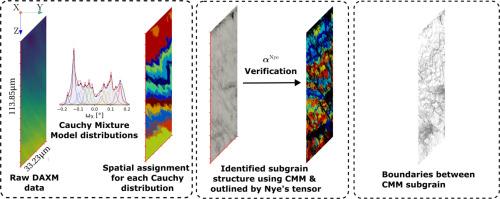Informed Unsupervised Machine Learning Analysis of Dislocation Microstructure from High-Resolution Differential Aperture X-ray Structural Microscopy Data
IF 9.3
1区 材料科学
Q1 MATERIALS SCIENCE, MULTIDISCIPLINARY
引用次数: 0
Abstract
This study leverages high-resolution differential-aperture X-ray structural microscopy (DAXM) to probe the local dislocation structure in deformed 304L-stainless steel at small strain, by measuring the lattice rotation and deviatoric elastic strain with a sub-micron resolution. For a single grain in a polycrystalline specimen, the measured lattice rotation field over the measured volume exhibited a multimodal distribution while the deviatoric elastic strain showed a single-mode distribution. An unsupervised Cauchy mixture machine learning model was developed to resolve the multimodal distribution of the lattice rotation. By mapping the lattice rotation data associated with each Cauchy peak in the model back onto the measured volume, we identify contiguous regions of the crystal rotated near the average values corresponding to the peaks of the overall rotation distribution. These regions represent the grain subdivision in the microstructure. Finally, the dislocation density tensor was also computed and its norm was laid over the rotation field to detect the subgrain boundaries. This step provided a validation of the Cauchy mixture model for the analysis of the lattice rotation distribution. The current study highlights the integration of advanced X-ray microscopy techniques with data-driven analysis methods to uncover detailed microstructure scales in deformed crystals.

基于高分辨率差孔径x射线结构显微镜数据的位错微观结构的无监督机器学习分析
本研究利用高分辨率差孔径x射线结构显微镜(DAXM),通过测量亚微米分辨率的晶格旋转和偏弹性应变,探测变形304l不锈钢在小应变下的局部位错结构。对于多晶样品中的单个晶粒,测量到的晶格旋转场在测量体积上呈现多模态分布,而偏弹性应变呈现单模态分布。为了解决晶格旋转的多模态分布问题,建立了一种无监督柯西混合机器学习模型。通过将模型中与每个柯西峰相关的晶格旋转数据映射回测量体积,我们识别出在总体旋转分布的峰值对应的平均值附近旋转的晶体的连续区域。这些区域代表了微观组织中的晶粒细分。最后,计算位错密度张量,并将其范数置于旋转场上以检测亚晶界。这一步为分析晶格旋转分布提供了柯西混合模型的验证。目前的研究强调了先进的x射线显微镜技术与数据驱动分析方法的集成,以揭示变形晶体中详细的微观结构尺度。
本文章由计算机程序翻译,如有差异,请以英文原文为准。
求助全文
约1分钟内获得全文
求助全文
来源期刊

Acta Materialia
工程技术-材料科学:综合
CiteScore
16.10
自引率
8.50%
发文量
801
审稿时长
53 days
期刊介绍:
Acta Materialia serves as a platform for publishing full-length, original papers and commissioned overviews that contribute to a profound understanding of the correlation between the processing, structure, and properties of inorganic materials. The journal seeks papers with high impact potential or those that significantly propel the field forward. The scope includes the atomic and molecular arrangements, chemical and electronic structures, and microstructure of materials, focusing on their mechanical or functional behavior across all length scales, including nanostructures.
 求助内容:
求助内容: 应助结果提醒方式:
应助结果提醒方式:


